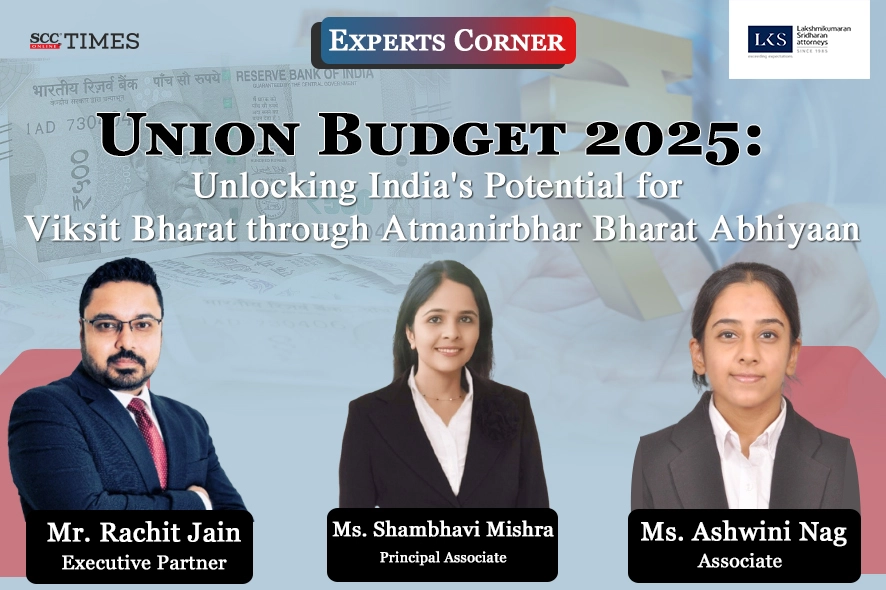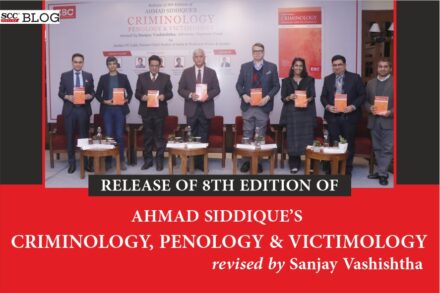“Only he who is self-supporting is free, self-reliant, independent.” — James Allen
The Union Budget (Budget) for the Financial Year 2025-2026 (FY 25-26) was presented by the Finance Minister of India on 1-2-2025. Accordingly, the Finance Bill, 2025 (Finance Bill)1 was tabled in the Lok Sabha, proposing and notifying various amendments, inter alia, in the Customs Act, 1962 (Customs Act)2 and the Customs Tariff Act, 19753 (Tariff Act).
The underlying theme of the Budget for the FY 25-26, as expressly discernible from the Minister’s Speech and the proposals in the Finance Bill, was the reiteration of promoting the “Atmanirbhar Bharat Abhiyaan” campaign introduced in 2020, with the objective of achieving an independent and self-reliant India.
This year, the Minister also expanded on the theme of Atmanirbhar Bharat and gave wings to the country’s journey towards the destination of “Viksit Bharat” i.e. Developed India. This vision of the Union Government is to transform India into a developed nation by the 100th anniversary of independence in 2047.4 As articulated in her Speech, this destination is to be journeyed towards by relying on the powerful engines of growth, namely, agriculture, micro, small & medium enterprise (MSME) and investment. The fuel for these engines will be the reforms introduced in the Finance Bill.
This article aims to analyse certain changes and policy decisions comprising the body of the engines of development, and which are in furtherance of the Atmanirbhar Bharat agenda.
Engines of development as per the Budget: MSME and investment
The Budget for the FY 25-26 has provided further boost to the vision of the Union Government by focusing on the engines of development, viz. Agriculture, MSME and Investment.5 Under the purview of these engines, the fuel of reform has been proposed in the form of earmarking of resources for improving local agricultural infrastructure, incentivisation of domestic manufacture in certain sectors, effective elimination of import tariffs for the parts, components, capital goods, etc. thereof required.
Agriculture as an engine: Increase in rates of AIDC
Amongst the most noticeable aspects in the Budget that have cleared several roads towards a self-reliant India, a perceivable facet has been the proposed increase in the rates of Agricultural Infrastructure and Development Cess (AIDC) on the imports of certain goods,6 such as footwear, semiconductors and motor vehicles,7 mostly without impacting the effective rate of customs duties.
The AIDC was first introduced by the Finance Minister vide the Union Budget for the Financial Year 2021-2022 (FY 21-22) with the intention of earmarking resources for improving agricultural infrastructure and conserving and processing agricultural output.8 While AIDC was initially imposed on a small number of goods, this year’s Budget has expanded the net for levy of cess to a wider category of goods.
MSME as an engine: Boost for critical minerals in India
As per this year’s Budget speech, over 1 crore registered MSMEs in India are generating 36% of India’s manufacturing. Further, these MSMEs are responsible for 45% of India’s exports.9 In view of this, the Minister has promised to set up a National Manufacturing Mission, which will be unique in the “Make in India” cause vis-à-vis the support provided to MSMEs.
Further, the Minister has proposed to provide a space for clean tech manufacturing to MSMEs, with the goal of improving domestic value addition. The basic customs duty (BCD) exemptions provided in the previous financial year and the policy decisions thereof for the FY 25-26 are enumerated below:
Union Budget, Financial Year 2024-2025 (FY 24-25)
(i) Full exemption from BCD to 25 critical minerals that are not domestically available, including lithium, copper, cobalt and rare earth elements.
(ii) Exemption for minerals which are critical for nuclear energy, renewable energy, defence, high-tech telecommunications, etc.
(iii) Stimulus for processing and refining of such minerals by MSMEs.
(iv) National Critical Minerals Mission was set up for inter alia domestic production, recycling of critical minerals, and overseas acquisition of critical mineral assets.10
(v) Commencement of a mobility mission for developing battery recycling in India as a sustainable method to ensure recovery of critical minerals and for assistance in extraction technologies.11
(vi) National Critical Minerals Mission was officially approved in January 2025, providing an elaborate framework for achieving self-reliance in the critical mineral sector.
Union Budget, FY 25-26
(i) Full exemption from BCD to cobalt powder and waste, scrap of lithium-ion battery, lead, zinc and 12 more critical minerals.
(ii) Securing availability of critical minerals for manufacturing in India and promote more jobs for youth.
(iii) Keenness for setting up battery recycling industry in India.
(iv) Incentivisation for imports of critical minerals too ensure ample availability for manufacture, use and reuse of lithium-ion batteries in India, especially by MSMEs.
The further incentives provided for the lithium-ion battery manufacturing sector are discussed below:
Lithium-ion battery manufacture in India: The golden era begins
As evident from the duty exemptions granted to critical minerals, the Union Government is leaving no stone unturned in giving an impetus for setting up a local lithium-ion battery manufacturing sector.
In this regard, the existing BCD exemptions12 were provided to various capital goods falling under different tariff headings, if imported for use for manufacture of lithium-ion cells used in further manufacture of electrically operated vehicles (EV) and mobile handsets.13
The Union Government vide the Budget for the FY 25-26 has now widened the list of capital goods exempted from BCD when imported for use in domestic manufacture of EV battery and mobile phone battery.14 This exemption has been made applicable w.e.f. 2-2-2025 for providing an instantaneous boost to the local manufacturers of lithium-ion batteries.15
Investment as an engine: Shipbuilding to advance India’s maritime potential
In addition to the boost provided to the above sectors to create domestic manufacturing hubs and deepen local value addition, the need for increasing India’s share of the global shipbuilding market has been emphasised time and again.16 Such need has been necessitated to reduce Indian reliance on the shipbuilding monopoly held by other Asian nations and also promote private investment in shipyards.17
The Shipbuilding Financial Assistance Policy (SBFAP) was introduced in 2016 to provide financial assistance to Indian shipyards for shipbuilding contracts signed between 2016 to 202618 to increase the domestic manufacture of different types of vessels.19
Vide the Budget for the FY 25-26, the shipbuilding policy has now been revamped by the Union Government, with a more cost efficient and investment heavy “SBFAP 2.0”.20 Additionally, the exemption from BCD on raw materials, components, consumables and parts used for the manufacture of ships has been extended for another 10 years i.e. till 31-3-2035.21
Concluding remarks
The above changes/proposals in the rates of BCD by the Union Government, read with the policy changes introduced in the critical minerals, lithium-ion battery and shipbuilding sectors can be assessed to have speedy, long-standing and effective impact on the domestic industries in India. Thus, the Budget for the FY 25-26 has once again affirmed the Union Government’s commitment to transform India to “Viksit Bharat” by 2047.
*Executive Partner, Lakshmikumaran and Sridharan Attorneys.
**Principal Associate, Lakshmikumaran and Sridharan Attorneys.
***Associate, Lakshmikumaran and Sridharan Attorneys.
1. Finance Bill, 2025.
4. PM India, “PM to Launch ‘Viksit Bharat @2047: Voice of Youth’ on 11th December”, (10-12-2023) available at <https://www.pmindia.gov.in/en/news_updates/pm-to-launch-viksit-bharat-2047-voice-of-youth-on-11th-december/>.
5. Finance Minister, Government of India in the Union Budget Speech, Financial Year 2025-2026.
6. Memorandum Explaining Provisions of Finance Bill, Financial Year 2025-2026.
7. Ministry of Finance, Annexure I to Tax Research Unit (TRU) Letter, D.O.F. No. 334/3/2025-TRU (Issued on 1-2-2025).
8. Finance Minister, Government of India in the Union Budget Speech, Financial Year 2021-2022.
9. Finance Minister, Government of India in the Union Budget Speech, Financial Year 2025-2026.
10. Press Release, Press Information Bureau, Government of India, Ministry of Mines, Cabinet Approves ‘National Critical Mineral Mission’ to Build a Resilient Value Chain for Critical Mineral Resources Vital to Green Technologies, with an Outlay of Rs 34,300 crore over Seven Years, 29-1-2025, available at <https://pib.gov.in/PressReleaseIframePage.aspx?PRID=2097309>.
11. Niti Aayog, “Mine to Market: Critical Minerals Supply Chain for Domestic Value Addition in Lithium-Ion Battery Manufacturing”, available at <https://www.niti.gov.in/sites/default/files/2023-07/Mine-to-market_NITI-Aayog-Publication_June-2023.pdf>.
12. The exemption from BCD for capital goods imported for manufacture of lithium-ion cells of mobile handsets was inserted to Ministry of Finance, Notification No. 25/2002-Customs (Notified on 1-3-2002) vide Ministry of Finance, Department of Revenue, Notification No. 71/2018-Customs (Notified on 28-9-2018). The exemption for capital goods imported for similar end use for EV batteries was inserted vide Ministry of Finance, Department of Revenue, Notification No. 6/2023-Customs (Notified on 1-2-2023).
13. Ministry of Finance, Notification No. 25/2002-Customs (Notified on 1-3-2002).
14. Ministry of Finance, Notification No. 11/2025-Customs (Notified on 1-2-2025).
15. Finance Minister, Government of India in the Union Budget Speech, Financial Year 2025-2026.
16. Department of Scientific and Industrial Research, “Shipbuilding — Executive Summary”, available at <https://www.dsir.gov.in/sites/default/files/2019-11/9_0.pdf>.
17. Rimjhim Singh “Gautam Adani to Start Shipbuilding at Mundra Port Amid Global Demand Surge”, Business Standard, available at <https://www.business-standard.com/companies/news/gautam-adani-to-start-shipbuilding-at-mundra-port-amid-global-demand-surge-124070900344_1.html>.
18. “Government Approves Guidelines for Implementation of Shipbuilding Financial Assistance Policy”, SCC OnLine Times, available at <https://www.scconline.com/blog/post/2016/07/08/guidelines-for-implementation-of-shipbuilding-financial-assistance-policy/>.
19. The SBFAP was introduced with the aim of helping shipbuilders secure orders and ensure their timely completion.
20. Press Release, Ministry of Ports, Shipping and Waterways, SBFAP 2.0 Revamped to Optimise Cost Disadvantages…., Press Information Bureau, available at <https://pib.gov.in/PressReleasePage.aspx?PRID=2098573>.
21. Ministry of Finance, Department of Revenue, Notification No. 50/2017-Customs (Notified on 30-6-2017).






